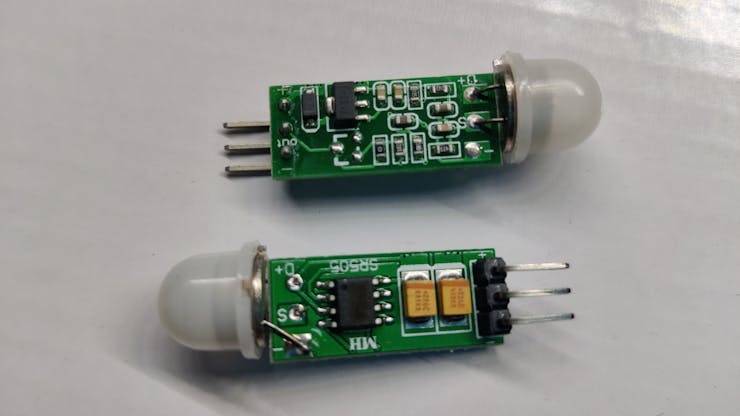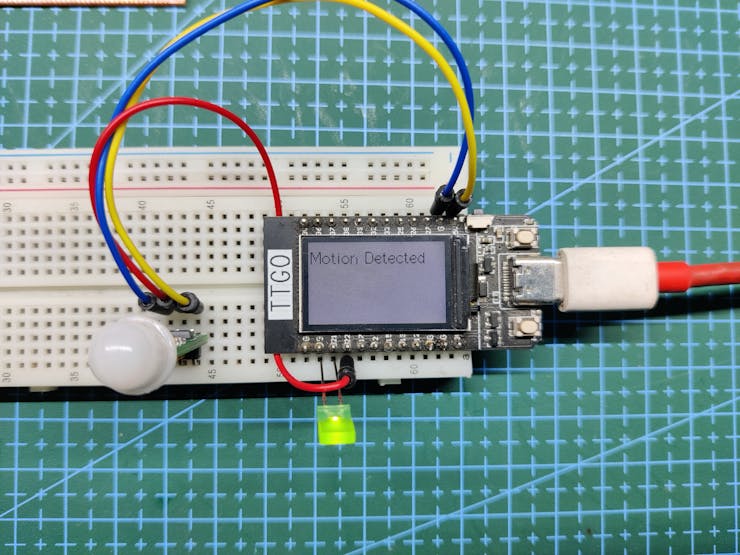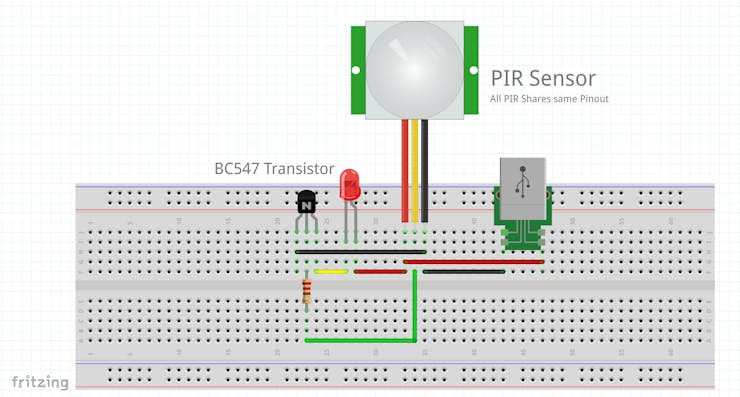
|
arduino IDEArduino
|
Motion Trigger Circuit with and without Microcontroller
Greetings
Here's a tutorial on how to use an HC-SR505 PIR Module with and without a microcontroller to drive XYZ Load when any motion is detected.
This Tutorial contains three different types of setups that we can use to prepare a Motion Detection Based Project like an automatic Hallway Light or Motion Detection Security System Etc.
Let's get started.
Material Required
Following are the materials used in this built-
- PIR HC-SR505 Module
- Attiny13A
- TTGO T Display Board
- LEDs
- Jumper Wires
- BC547
- Breadboard
- USB Micro Port Breakout board
HC-SR505

HC-SR505 is a PIR Sensor that picks up infrared radiation emitted by the body and then outputs a signal based on the motion of a body.
You see, as we move, our body emits more and more infrared radiation that is picked up by this sensor.
Following are its electrical parameters and features-
- Operating Voltage Range: DC4.5-20V
- Static current:<60uA
- Output level: High 3.3V / Low 0V
- Trigger: repeatable trigger
- Delay time: Default 8S + -30% (can be customized range of a few tenths - tens of minutes)
- PCB Dimensions: 10 * 23mm
- Induction angle:<100 degree cone angle
- Induction distance: 3 meters
- Working temperature: -20 - +80 degrees
- Sensor Lens Dimensions: Diameter: 10mm
As for its working and implementation in real-life projects, we provide VCC and GND of this module with 5V.
We add an LED's VCC Pin on the signal Pin of this module and connect the GND of the LED with the GND of the Module.


This will be the first and most basic Setup we can prepare with this module.
Just by standing near this sensor, It turns ON the LED, LED will stay ON for 8 seconds and then turn OFF, if we are near the 3M Radius of this module, the LED will turn ON again.




As for sourcing the HC-SR505, I got it from PCBWAY's Giftshop.
Aside from PCB Services, PCBWAY also has a dedicated components store.
PCBWAY GIFTSHOP is an online marketplace from where we can source all the major electronics stuff, like Arduino boards, Raspberry Pi boards, Modules, sensors, etc.
PCBWAY have this system that lets us purchase anything from their gift shop through beans, Beans are like a redeemable currency or coupons that we get by placing an order on PCBWAY or by sharing your projects in the community to get beans.
Check PCBWAY out for getting great PCB service from here- https://www.pcbway.com/
With Microcontroller TTGO T Display


Here's the second setup that uses a TTGO T Display board to Turn ON and OFF an LED and also display a message when motion is detected on its onboard RGB Display.
Preparing TTGO Board for Arduino IDE
we first have to install board files for ESP32 by putting this link in the preferences of the Arduino IDE Settings and then installing the boards through the board manager.
https://dl.espressif.com/dl/package_esp32_index.json
Installing TFT_eSPI Library and making changes in User Setup


We then move on to the next step which is to install the TFT_eSPI Library that enables us to use the display onboard.
Next, we go to C:\Users\ACER\Documents\Arduino\libraries\TFT_eSPI and make changes in the User Setup.h by replacing it with User setup for TTGO T Display.
The default one is set for ILI9430 Display and we change it for TTGO T Display by adding // in front of ILI9430 User setup and removing // in front of TTGO T Display.
Connections - Wiring
next, we connect everything by following the attached wiring diagram image.
- VCC of PIR to 5V of TTGO
- GND to GND
- Signal Pin of PIR to D22
- LED's VCC to D21
- LED GND to GND
Sketch for TTGO
Here's the code we use.
#define sensor 22 #define LED 21 #include <TFT_eSPI.h> // Graphics and font library for ST7735 driver chip #include <SPI.h> #define TFT_GREY 0x5AEB // New color TFT_eSPI tft = TFT_eSPI(); // Invoke library, pins defined in User_Setup.h void setup() { Serial.begin(9600); pinMode(sensor, INPUT); pinMode(LED, OUTPUT); digitalWrite(sensor, LOW); digitalWrite(LED, LOW); tft.init(); tft.setRotation(1); } void loop() { tft.fillScreen(TFT_GREY); tft.setCursor(4, 10, 2); tft.setTextColor(TFT_BLACK,TFT_GREY); tft.setTextSize(2); if (digitalRead(sensor)) { tft.println("Motion Detected"); digitalWrite(LED, HIGH); } else { tft.setCursor(4, 10, 2); tft.setTextColor(TFT_BLACK,TFT_GREY); tft.setTextSize(2); tft.println("No Movement"); digitalWrite(LED, LOW); } delay(50); }
It uses TFT_eSPI Library to display a message on the onboard RGB Display as soon as the board receives the signal from PIR Module, also the board triggers an LED depending on the signal received.
Working


We supply board 5V through the USB Cable and the setup will start functioning as it should. When we move in front of the module within a radius of 3M, PIR detects the movement and sends a signal to the TTGO Board that displays a message of signal detection and also turns ON the LED connected on D21.
Attiny85 Standalone setup

Here's another setup that is similar in working with the TTGO Version but uses a single Attiny85 MCU that significantly reduces the number of components.
Attiny85 is an AVR MCU that has 8 KB ISP Flash memory, 512B EEPROM, and 512B SRAM which is enough for driving a load with PIR Sensor as its sketch is small in size so it would be an overkill to use an ESP32 Device in this project.
Connections - Wiring
We connect everything by following the attached wiring diagram image.
- VCC of PIR to VCC of Attiny
- GND to GND
- Signal Pin of PIR to D0 of Attiny
- LED's VCC to D1 of Attiny
- LED GND to GND
- USB Micro Breakout's VCC to VCC of Attiny
- USB Micro Breakout's GND to GND of Attiny
Sketch for Attiny
Here's the code I used for flashing the attiny85.
#define sensor 0 #define LED 1 void setup() { pinMode(sensor, INPUT); pinMode(LED, OUTPUT); digitalWrite(sensor, LOW); digitalWrite(LED, LOW); } void loop() { if (digitalRead(sensor)) { digitalWrite(LED, HIGH); } else { digitalWrite(LED, LOW); } delay(50); }
The sensor is connected with the D0 pin and the LED is connected with the D1 Pin.
When the Sensor picks any motion, it sends a signal to D0 and MCU triggers D1 Pin that turns ON the LED.
Result
Here's the result of the Attiny85 Setup.

Pros of using this setup are its size and form factor, it can be easily used in a custom board and it's minimal, we don't need any other components to properly run it which is a plus point of using this small MCU in a lighting-related project that I'm already working on.
Without Microcontroller


Here's the third setup that is similar to the first one, the only difference here is an additional NPN Transistor that drives a load by changing the state of the transistor's base through the PIR Signal Pin.
Connection- Wiring
We connect an NPN transistor with the PIR setup by connecting a load with it through the collector and connecting its base with the signal pin of the PIR Module.
Here, the BC547 Transistor is Setup in the "transistor as switch" configuration that is commonly used to turn ON-OFF XYZ stuff like LEDs, Relays, etc.
RESULT


Here's the result, the setup is working and the loads are working properly.
Similarly, we can add a Mosfet in place of a Transistor to drive bigger loads like a motor or high power led, even relays.
Conclusion

PIR works with all three setups but the best one would be the attiny85 setup as we can control the ON Timing and even add three more loads as three I/O Pins are vacant.
As for the TTGO T Display board, using it was fun because of the display but it's not ideal for implementation in a small lighting-related project because of its big size and overkill for such a low level.
A simple setup with NPN Transistor also worked but there was an issue of uncontrollable timing of the load which can be controlled only if we add another OP Amp setup with it that can control the output's duration.
By utilizing the Attiny85 and a transistor, I will prepare an automatic hallway light board that will turn ON-OFF and an AC light through a relay.
Stay tuned for the next project!
DM me or leave a comment if you need any help regarding this project.
Thanks PCBWAY for supporting this project, you guys can check them out if you need great PCB Service for less cost.
Peace out.
#define sensor 22
#define LED 21
#include <TFT_eSPI.h> // Graphics and font library for ST7735 driver chip
#include <SPI.h>
#define TFT_GREY 0x5AEB // New color
TFT_eSPI tft = TFT_eSPI(); // Invoke library, pins defined in User_Setup.h
void setup()
{
Serial.begin(9600);
pinMode(sensor, INPUT);
pinMode(LED, OUTPUT);
digitalWrite(sensor, LOW);
digitalWrite(LED, LOW);
tft.init();
tft.setRotation(1);
}
void loop()
{
tft.fillScreen(TFT_GREY);
tft.setCursor(4, 10, 2);
tft.setTextColor(TFT_BLACK,TFT_GREY);
tft.setTextSize(2);
if (digitalRead(sensor)) {
tft.println("Motion Detected");
digitalWrite(LED, HIGH);
}
else {
tft.setCursor(4, 10, 2);
tft.setTextColor(TFT_BLACK,TFT_GREY);
tft.setTextSize(2);
tft.println("No Movement");
digitalWrite(LED, LOW);
}
delay(50);
}
#define sensor 0
#define LED 1
void setup()
{
pinMode(sensor, INPUT);
pinMode(LED, OUTPUT);
digitalWrite(sensor, LOW);
digitalWrite(LED, LOW);
}
void loop()
{
if (digitalRead(sensor)) {
digitalWrite(LED, HIGH);
}
else {
digitalWrite(LED, LOW);
}
delay(50);
}
Motion Trigger Circuit with and without Microcontroller
- Comments(0)
- Likes(2)
-
 Anthony Pedotto
Feb 22,2025
Anthony Pedotto
Feb 22,2025
-
 (DIY) C64iSTANBUL
Jul 21,2022
(DIY) C64iSTANBUL
Jul 21,2022
- 0 USER VOTES
- YOUR VOTE 0.00 0.00
- 1
- 2
- 3
- 4
- 5
- 6
- 7
- 8
- 9
- 10
- 1
- 2
- 3
- 4
- 5
- 6
- 7
- 8
- 9
- 10
- 1
- 2
- 3
- 4
- 5
- 6
- 7
- 8
- 9
- 10
- 1
- 2
- 3
- 4
- 5
- 6
- 7
- 8
- 9
- 10
 More by Arnov Arnov sharma
More by Arnov Arnov sharma
-
 Pocket SNES
Greetings everyone, and welcome back! Today, I’ve got something fun and tiny to share—the Pocket SNE...
Pocket SNES
Greetings everyone, and welcome back! Today, I’ve got something fun and tiny to share—the Pocket SNE...
-
 Batocera Arcade Box
Greetings everyone and welcome back, Here's something. Fun and nostalgic. Right now, we are using ou...
Batocera Arcade Box
Greetings everyone and welcome back, Here's something. Fun and nostalgic. Right now, we are using ou...
-
 64x32 Matrix Panel Setup with PICO 2
Greetings everyone and welcome back.So here's something fun and useful: a Raspberry Pi Pico 2-powere...
64x32 Matrix Panel Setup with PICO 2
Greetings everyone and welcome back.So here's something fun and useful: a Raspberry Pi Pico 2-powere...
-
 Portable Air Quality Meter
Hello everyone, and welcome back! Today, I have something incredibly useful for you—a Portable Air Q...
Portable Air Quality Meter
Hello everyone, and welcome back! Today, I have something incredibly useful for you—a Portable Air Q...
-
 WALKPi PCB Version
Greetings everyone and welcome back, This is the WalkPi, a homebrew audio player that plays music fr...
WALKPi PCB Version
Greetings everyone and welcome back, This is the WalkPi, a homebrew audio player that plays music fr...
-
 Delete Button XL
Greetings everyone and welcome back, and here's something fun and useful.In essence, the Delete Butt...
Delete Button XL
Greetings everyone and welcome back, and here's something fun and useful.In essence, the Delete Butt...
-
 Arduino Retro Game Controller
Greetings everyone and welcome back. Here's something fun.The Arduino Retro Game Controller was buil...
Arduino Retro Game Controller
Greetings everyone and welcome back. Here's something fun.The Arduino Retro Game Controller was buil...
-
 Super Power Buck Converter
Greetings everyone and welcome back!Here's something powerful, The SUPER POWER BUCK CONVERTER BOARD ...
Super Power Buck Converter
Greetings everyone and welcome back!Here's something powerful, The SUPER POWER BUCK CONVERTER BOARD ...
-
 Pocket Temp Meter
Greetings and welcome back.So here's something portable and useful: the Pocket TEMP Meter project.As...
Pocket Temp Meter
Greetings and welcome back.So here's something portable and useful: the Pocket TEMP Meter project.As...
-
 Pico Powered DC Fan Driver
Hello everyone and welcome back.So here's something cool: a 5V to 12V DC motor driver based around a...
Pico Powered DC Fan Driver
Hello everyone and welcome back.So here's something cool: a 5V to 12V DC motor driver based around a...
-
 Mini Solar Light Project with a Twist
Greetings.This is the Cube Light, a Small and compact cube-shaped emergency solar light that boasts ...
Mini Solar Light Project with a Twist
Greetings.This is the Cube Light, a Small and compact cube-shaped emergency solar light that boasts ...
-
 PALPi V5 Handheld Retro Game Console
Hey, Guys what's up?So this is PALPi which is a Raspberry Pi Zero W Based Handheld Retro Game Consol...
PALPi V5 Handheld Retro Game Console
Hey, Guys what's up?So this is PALPi which is a Raspberry Pi Zero W Based Handheld Retro Game Consol...
-
 DIY Thermometer with TTGO T Display and DS18B20
Greetings.So this is the DIY Thermometer made entirely from scratch using a TTGO T display board and...
DIY Thermometer with TTGO T Display and DS18B20
Greetings.So this is the DIY Thermometer made entirely from scratch using a TTGO T display board and...
-
 Motion Trigger Circuit with and without Microcontroller
GreetingsHere's a tutorial on how to use an HC-SR505 PIR Module with and without a microcontroller t...
Motion Trigger Circuit with and without Microcontroller
GreetingsHere's a tutorial on how to use an HC-SR505 PIR Module with and without a microcontroller t...
-
 Motor Driver Board Atmega328PU and HC01
Hey, what's up folks here's something super cool and useful if you're making a basic Robot Setup, A ...
Motor Driver Board Atmega328PU and HC01
Hey, what's up folks here's something super cool and useful if you're making a basic Robot Setup, A ...
-
 Power Block
Hey Everyone what's up!So this is Power block, a DIY UPS that can be used to power a bunch of 5V Ope...
Power Block
Hey Everyone what's up!So this is Power block, a DIY UPS that can be used to power a bunch of 5V Ope...
-
 Goku PCB Badge V2
Hey everyone what's up!So here's something SUPER cool, A PCB Board themed after Goku from Dragon Bal...
Goku PCB Badge V2
Hey everyone what's up!So here's something SUPER cool, A PCB Board themed after Goku from Dragon Bal...
-
 RGB Mixinator V2
Hey Everyone how you doin!So here's a fun little project that utilizes an Arduino Nano, THE MIXINATO...
RGB Mixinator V2
Hey Everyone how you doin!So here's a fun little project that utilizes an Arduino Nano, THE MIXINATO...
-
-
AEL-2011 Power Supply Module
524 0 2 -
AEL-2011 50W Power Amplifier
485 0 2 -
-
-
Custom Mechanical Keyboard
693 0 0 -
Tester for Touch Screen Digitizer without using microcontroller
329 2 2 -
Audio reactive glow LED wristband/bracelet with NFC / RFID-Tags
310 0 1 -
-
-























































